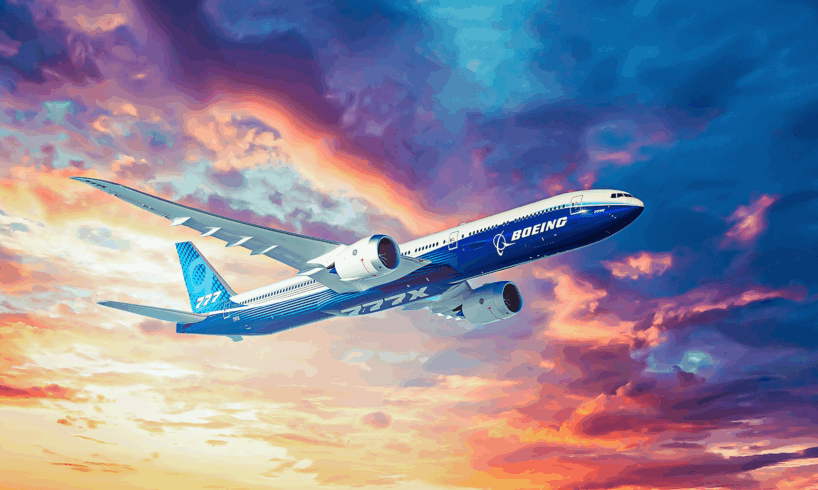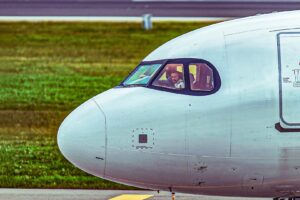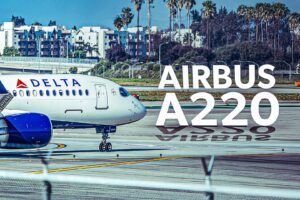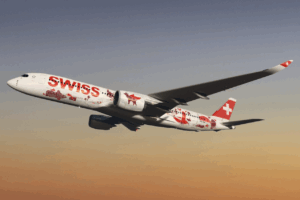
The Boeing 777 is the world’s largest twinjet airliner and the most built widebody commercial airliner. The aircraft was originally developed to bridge the gap between two other popular Boeing airliners, the Boeing 767 and the “Queen of the Skies”, the Boeing 747. It also replaced aging McDonnell Douglas DC-10s and Lockheed L-1011 TriStars that had previously flown commercially. The newest variant of the Boeing 777 series has been designated the Boeing 777X. The third variant of this series is scheduled to enter service in 2026, continuing to revolutionize the skies.
Boeing 777
First Delivery
May 15, 1995
Beyond the airliner variant of the Boeing 777X series, Boeing
also intends to begin delivering a Boeing 777X Freighter and a Boeing Business Jet (BBJ) 777X variant. The BBJ variant will most likely be delivered to governments and private customers, most likely for VIP transport. This will follow other Boeing Business Jets, such as the BBJ 737 MAX, the BBJ 787, and the BBJ Select, each of which finds success in the private aviation industry. Let’s take a closer look at the BBJ 777X, a unique private jet that will dominate the skies in the near future. Let’s also take a look at some of the features that will make this aircraft so competitive in the business jet industry.
Design Origins And Initial Concept
Photo: km30192002 via Wikimedia Commons
The original concepts of the Boeing 777
can be traced back to the 1980s. The Boeing 747, McDonnell Douglas DC-10, and the Lockheed L-1011 TriStar were the most frequently flown widebody airliners. However, in the 1980s, these popular aircraft were expected to begin retiring, which led many popular aircraft manufacturers to begin developing their own widebody airliners as replacements. This included Boeing, which eventually settled on developing a clean-sheet design in the late 1980s.
The official program was developed with considerable input from a wide variety of existing airlines. These partnerships helped Boeing decide to develop a baseline configuration. This included a cabin cross-section that was similar to the Boeing 747, a maximum capacity of up to 325 passengers, customizable interior cabins, a glass cockpit, fly-by-wire flight controls, and an improvement in seat-mile costs compared to other developing widebody airliners. The airlines that partnered with Boeing include:
All Nippon Airways
American Airlines
British Airways
Cathay Pacific
Delta Air Lines
Japan Airlines
Qantas
United Airlines
The Boeing 777 was developed entirely using a computer-aided design (CAD) process, the first aircraft in the industry to do so. It also utilized fly-by-wire flight controls, the first commercial aircraft to do so, which also utilized conventional yokes in the cockpit. The Boeing 777 utilized composite materials to lighten the aircraft and also featured a supercritical airfoil design on its wings. The aircraft can be powered by an engine from several different manufacturers, including the General Electric GE90, the Pratt & Whitney PW4000, and the Rolls-Royce
Trent 800, each of which powers the aircraft with at least 77,200 pounds of thrust.
Related
Will The Boeing 777X Be As Successful As Industry Analysts Expect?
The Boeing 777X, one of the largest widebody aircraft ever to take to the skies, will surely have a lasting impact on the market. However, many have claimed that the Boeing 777X will be one of the biggest game-changers aviation has seen in the better part of a century. With an extra-wide fuselage, there’s no doubt that the plane will be one of the highest-capacity jets to enter the market in the next decade. However, with manufacturer Boeing saddled with production delays, many have begun to wonder whether the Boeing 777X will actually live up to expectations. Despite this, many airlines have still placed big orders for the aircraft, with many planning that it will soon serve as the cornerstone of their long-haul fleets. What do you think? Will the Boeing 777X meet the extremely ambitious expectations already placed on it?
Development And Scheduled Commercial Launch
Photo: Minh K Tran | Shutterstock
The launch of the Boeing 777 program directly aligned with United Airlines’ intent to begin retiring its DC-10s. Because of this, United Airlines
became the launch customer for the new program, placing an order for 34 777s powered by Pratt & Whitney
engines, with options for 34 more aircraft. United Airlines believed this aircraft would be able to immediately service the following routes:
The first prototype aircraft rolled out from Boeing’s Everett, Washington-based facility in April 1994. The first flight of a Boeing 777 occurred on June 12, 1994, which also began the extensive flight testing process. This process took Boeing nearly a year, the longest of any Boeing airliner at the time.
The Federal Aviation Administration (FAA) awarded the Boeing 777 its certification on April 19, 1995, followed by the European Joint Aviation Authorities (JAA). Boeing delivered its first commercial 777 to United Airlines on May 15, 1995, and the airline flew the first commercial service from London Heathrow Airport (LHR) to Dulles International Airport (IAD) on June 7, 1995.
The Several Different Boeing 777 Variants
Photo: Markus Mainka | Shutterstock
Over the years, Boeing has introduced several improved variants of the 777. The first aircraft was designated the 777-200, which was targeted at mostly US domestic airlines. Additionally, Boeing made several improvements to this variant. This includes the 777- 200ER, which designates its extended range. It has an additional fuel capacity that allows it to reach a maximum range of 7,065 nautical miles (8,130 miles) with 301 passengers. Boeing also introduced the Boeing 777-200LR Worldliner, although it typically coincides with the second generation series. This aircraft has a maximum range of 8,555 nautical miles (9,845 miles), making it one of the furthest-reaching commercial airliners.
The second generation of 777s is designated the 777-300. This variant was first announced at the Paris Air Show in 1995 and was later introduced with Air France. Its fuselage was 20% longer than earlier variants, and it could fit a maximum of 550 passengers in a high-density configuration. It could also reach a range of about 6,005 nautical miles (6,910 miles). Other second-generation aircraft include the 777-300ER and the 777-300F, a freighter variant.
The latest generation of the Boeing 777 has been designated the 777X. It was first introduced in the early 2010s, with Lufthansa scheduled to be the launch customer. It flew for the first time on January 25, 2020, with production continuing at the Boeing Everett Factory. Several delays have postponed its launch date, as it was initially scheduled to enter service in 2019. Boeing currently expects the first 777X aircraft to be delivered in 2026.
Related
Which Airlines Have Ordered The Most Boeing 777Xs?
Boeing’s ongoing production issues have led to a 6,000-strong backlog. Despite the delays, airlines continue to make firm commitments for the 777X.
The History Of The Boeing Private Jet
Photo: Eddie Maloney | Wikimedia Commons
Boeing is best known for its production of commercial airliners. However, in the late 1990s, Boeing introduced a corporate business segment titled Boeing Business Jets. This segment modified existing Boeing airliners into business jets, typically for use by private operators, heads of state, or businesses.
The first Boeing Business Jet (BBJ) was called the BBJ1 and was based on the popular Boeing 737-700. However, Boeing added stronger wings, landing gear, and nine auxiliary fuel tanks to boost the aircraft’s range. This allowed the BBJ1 to reach a range of 6,000 nautical miles (6,900 miles). Boeing also released several other narrowbody variants based on the Boeing 737
series, called the BBJ2 and the BBJ3, with nearly 150 total aircraft delivered.
Boeing Business Jets has released other converted business jets based on popular airliner offerings. This includes the BBJ 747-8, with 17 total aircraft delivered, and the BBJ 777, also with 17 total aircraft delivered. Currently, the company offers a BBJ 787 variant and will soon offer a business jet variant based on the incoming 777X, called the BBJ 777X.
Design Features And Performance Specifications Of The Boeing 777X Private Jet
Photo: Boeing
The 777X will be largely based on the incoming Boeing 777X series, with several upgrades. These improvements include the 3.5-meter (11.5-feet) folding wingtips found on some 777 variants. This upgrade, along with several additional fuel tanks, helps the aircraft achieve the following performance specifications:
Specification
BBJ 777-8
BBJ 777-9
Length
229 feet
251 feet nine inches
Height
63 feet eleven inches
64 feet one inch
Wingspan
235 feet five inches
235 feet five inches
Maximum takeoff weight (MTOW)
775,000 pounds
775,000 pounds
Range
11,835 nautical miles (13,619 miles)
11,330 miles (13,040 miles)
Maximum speed
Mach 0.85 (652 miles per hour)
Mach 0.85 (652 miles per hour)
This aircraft series was first announced in December 2018 at the Middle East Business Aviation Association Show. The BBJ 777X is expected to enter service in 2026, with the freighter variant expected to enter service in 2028.
Related
A Look At The Award Winning Interior Of This Boeing Business Jet BBJ777
With the brand-new 777X coming live very soon, the German MRO company developed a new concept based on the 777-9 for the upcoming BBJ777X.
The Incoming Legacy Of The Boeing 777X
The new BBJ 77X will change the way that private operators and VIP customers take to the skies. This private jet will have the capability to fly nonstop anywhere in the world, as it has a range of over 11,000 nautical miles (12,658). It is also being developed with cutting-edge technology, similar to the Boeing 777, powered by the General Electric
GE9X. This powerful and efficient engine provides the aircraft with 110,000 pounds of thrust.
The BBJ 777X will also demonstrate a new fully customizable interior, which can have a maximum of 3,692 square feet of cabin space. This cabin can be broken into large entryways, spacious living areas, private rooms, staterooms, or even VIP lavatories. Overall, the BBJ 777X series will have the following cabin dimensions:
Dimensions
BBJ 777-8
BBJ 777-9
Cabin Area
3,322 square feet
3,689 square feet
Cabin length
184 feet
203 feet
Cabin height
Eight feet four inches
Eight feet four inches
Cabin width
19 feet seven inches
19 feet seven inches
Additionally, Boeing will incorporate smooth ride technology, which utilizes sensors to detect turbulence and automatically actuate flight control surfaces to improve ride quality. Furthermore, the windows on this aircraft are electronically dimmed. The BBJ 777X also features a cabin altitude of 6,000 feet, further improving the joy of flying and changing the way that business jets are flown.






